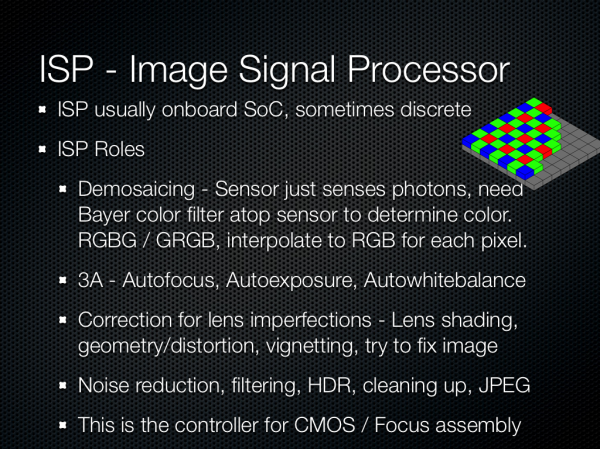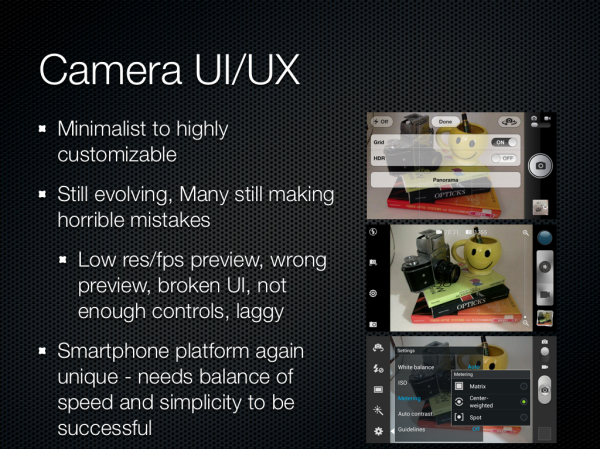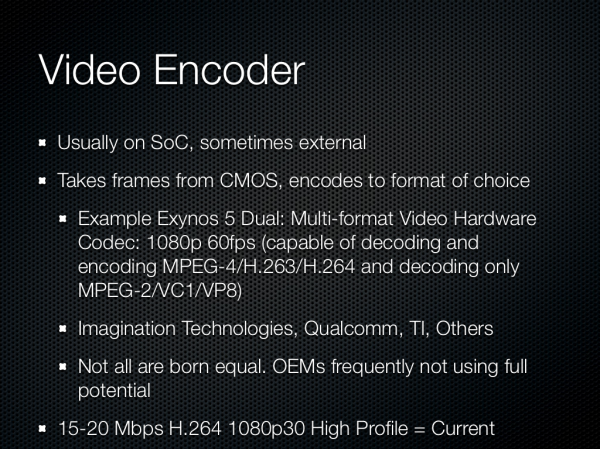Understanding Camera Optics & Smartphone Camera Trends, A Presentation by Brian Klug
by Brian Klug on February 22, 2013 5:04 PM EST- Posted in
- Smartphones
- camera
- Android
- Mobile
The Image Signal Processor (ISP)
So what purpose does ISP have? Well, pixels are sensitive to light between some set of wavelengths, essentially they’re color agnostic. The way to get a color image out is to put a filter on top, usually a bayer pattern color filter, then interpolate the color of the pixels adjacent. Your 8 MP CMOS doesn’t sense red green and blue for each pixel, it senses one color for each, then ISP guesses the color based on what’s next to it. This is called demosaicing, and it’s probably the primary job of ISP, and there are many secret sauce methods to computing this interpolated image. In addition ISP does all the other housekeeping, it controls autofocus, exposure, and white balance for the camera system. Recently correcting for lens imperfections like vignetting or color shading imparted by the imperfect lens system (which you’ll add right back in with instagram, you heathen) has been added, along with things like HDR recombining, noise reduction, other filtering, face or object detection, and conversion between color spaces. There’s variance between the features that ISP does, but this is really the controller for getting that bayer data into a workable image array.
Obviously the last part is the human interface part of the equation, which is an ongoing pain point for many OEMs. There are two divergent camps in smartphone camera UX – deliver almost no options, let the ISP and software configure everything automatically (Apple), and offer nearly every option and toggle that makes sense to the user (Samsung). Meanwhile other OEMs sit somewhere in-between (HTC, others). The ideal is an opt-in option for allowing users to have exposure control, with safe naive-user defaults. There are still many players making horrible, almost unthinkable mistakes in this area too. I wrote about how the iPhone 5 crops the preview to a 16:9 size, yet captures a 4:3 image, and later was amazed to see the AOSP camera UI on the Nexus 4 deliver an arbitrary shape (not even 16:9 or something logical) crop in the preview, and also capture a 4:3 image. Composition unsurprisingly matters when taking a photograph, and it’s mind-blowing to see established players blow off things like preview. In addition, preview framerate and resolution can be an issue on some platforms, to say nothing of outright broken or unstable user interfaces on some devices. Many OEMs have been thrust into crafting a camera UI who really have limited to no camera experience — previously it was a feature to have a camera period, much less controls. As the smartphone evolves from being a camera of convenience to the primary imaging device for most people, having robust controls for when ISP and auto exposure functionalities fail will become important. Right now camera UI and UX is rapidly changing from generation to generation, with more and more serious toggles being added. I don’t think any one player has a perfect solution yet.
For video we need to also consider the encoder. The pipeline is much the same, though the ISP will usually request a center crop or subsample from the CMOS, depending on the capabilities of the sensor. The encoder takes these images and compresses them into a format and bitrate of the OEM or user’s choice, basically H.264 at present. Not every encoder is the same, as Ganesh will tell you. There are a number of players in this market supplying IP blocks, and other players using what they have built in-house. Many OEMs make interesting choices to err on the side of not using too much storage, and don’t encode at the full capabilities of the encoder. This latest generation of phones we saw settle somewhere between 15 and 20 Mbps H.264 high profile for 1080p30 video.













60 Comments
View All Comments
MrSpadge - Sunday, February 24, 2013 - link
You're right, conceptually one would "only" need to adapt a multi-junction solar cell for spatial resoluition, i.e. small pixels. This would introduce shadowing for the bottom layers similar to front side illumination again, though. Which might be countered with vias through the chips, at the cost of making manufacturing more expensive. And the materials and their processing become way more expensive in general, as they will be CMOS incompatible III-V composites.And worst: one could only gain a 3 times higher light sensitivity at maximum, so currently it's probably not worth the effort.
mdar - Thursday, February 28, 2013 - link
I think you are talking about Foveon sensors, used by Sigma to make some of their DSLR cameras. Since photons of different colors have different energies, they use this principle to detect color. Not sure how they do it (probably by checking at which depth the electron is generated), but there is lot of information on web about it.fuzzymath10 - Saturday, February 23, 2013 - link
one of the non-traditional imaging sensors around is the foveon x3 sensor. each pixel can sense all three primary colours rather than relying on bayer interpolation. it does have many limitations though.evonitzer - Wednesday, February 27, 2013 - link
Yeah, like only being in Sigma cameras that use Sigma mounts. Who on earth buys those things? The results are stunning to see, but they need some, well, design wins, to use the parlance of cell phones.They also need to make tiny sensors. AFAIK they only have the APS-C one, and those won't be showing up in phones anytime soon. :)
ShieTar - Tuesday, February 26, 2013 - link
The camera equivalent of a 3 LCD projector does exist, for example in so-called "Multi-Spectral Imager" instruments for space missions. The light entering the camera aperture is split into spectral bands by dichroic mirrors, and then imaged on a number of CCDs.The problem with this approach is that it takes considerable engineering effort to make sure that all the CCDs are aligned to each other with sub-pixel accuracy. Of course the cost of multiple CCDs and the space demand for the more complex optical system make this option quiet irrelevant for mobile devices.
nerd1 - Friday, February 22, 2013 - link
I wonder who actually tested the captured image using proper analysing software (Dxo for example) to see how much they ACTUALLY resolve?And I don't think we get diffraction limit of 3um - see the chart here
http://egami.blog.so-net.ne.jp/2011-07-11
We have 1.34um at f2.0 and 1.88um at f2.8.
Typical 8MP sensor have 1.4um photosites so 8MP sensors looks like an ideal spot for f2 optics. (Yes, 13MP @ 1.1um is just marketing gimmick I think)
In comparison, 36MP Nikon D800 has 4.9um photosite size, which is diffraction limited between f5.6 and f8.
jjj - Friday, February 22, 2013 - link
"smartphones are or are poised to begin displacing the role of a traditional point and shoot camera "That started quite a while ago so a rather disappointing "trends"section. Was waiting for some actual features , ways to get there. and more talk about video since it's becoming a lot more important.
Johnmcl7 - Friday, February 22, 2013 - link
Agreed, the presentation feels a bit out of date for current technology particularly as you say phone cameras have been displacing compact cameras for years - I'd say right back to the N95 which offered a decent 5MP AF camera and was released before the first Iphone.I'm also surprised to see no mention of Nokia pretty much even though they've very much been pushing the camera limits, their ultra high resolution Pureview camera showed you could have a very high number of pixels and high image quality (which this article seems to claim isn't possible even with lower resolution devices) and the Lumia 920 is an interesting step forward in having a physical image stabilisation system.
Also with regards to shallow depth of field with F2, that's just not going to happen on a camera phone because depth of field is primarily a function of the actual focal length (not the equivalent focal length) so to get a proper shallow depth of field effect (as in not shooting at very close macro distances) a camera phone would need a massive aperture many stops wider than F2 to counter the very short focal length.
John
Tarwin - Saturday, February 23, 2013 - link
Actually it makes sense he doesn't mention all that. He's talking about trends, the Pureview did not fit into the trends, both in quality and sensor size.Optical image stabilization doesn't fit in either as it only affects image quality in less than ideal situations such as no tripods/shaky hands. But he did mention the need for extra parts in the module configuration shouldnthat be part of the setup.
And in his defence of the comment ofndisplacing P&S cameras, he says "smartphones are or are poised to begin displacing the role" so he's notnsaying that they aren't doing it already, he gives you a choice in perspectives. Also I don't think you can say the N95 displaced P&S at the market level, only in casual use.
Manabu - Friday, February 22, 2013 - link
What about the "large" sensor 41MP Nokia 808 phone? It is sure a interesting outlier.And point & shot cameras still have the advantage of optical zoom, better handling, and can have bigger sensors. Just look at S110, LX7 or RX100 cameras. But budget super-compact cameras are indeed in extinction.